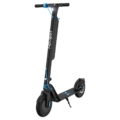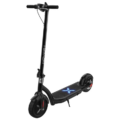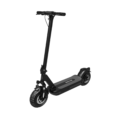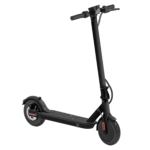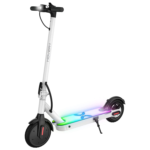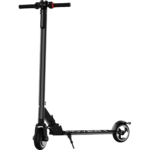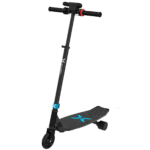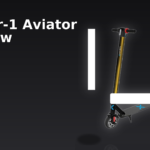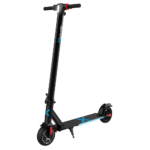- Home
- Scooters
- Electric Scooters
- Hover-1 Dynamo
Hover-1 Dynamo


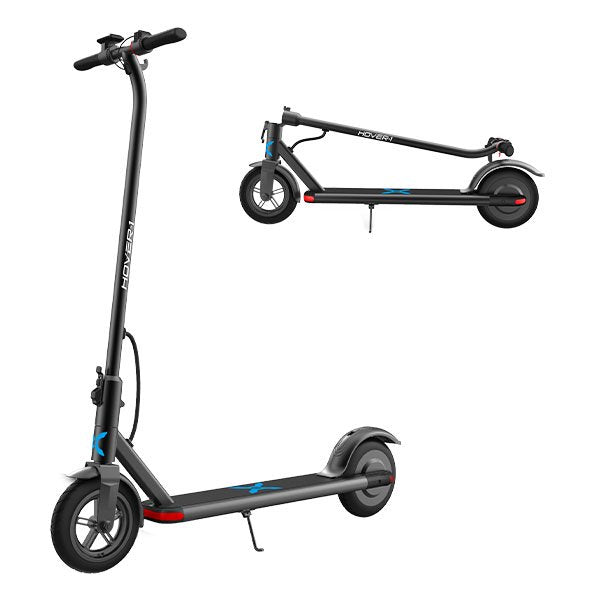
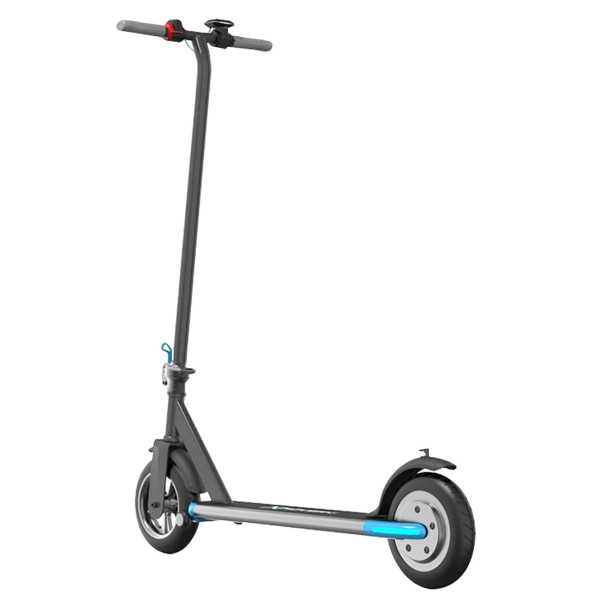
- Battery Range: 9 miles (14 km)
- Top Speed: 16 mph (26 km/h)
- Motor Power: 250 W
- Weight Capacity: 264 lb (119.7 kg)
- Charging Time: Approx. 4–5 h
- Scooter Weight: 30.9 lb (14.0 kg)
PROS
- 16 mph (26 km/h) top speed
- 8.5″ pneumatic tires
- Rear suspension for smoother ride
- LCD display with speed and battery
- 264 lb (120 kg) capacity
CONS
- Range limited to about 9 miles (14 km)
- Basic braking (electronic + foot)
- No app; IP rating not specified
Table of contents
- What Is the Hover-1 Dynamo?
- How the Hover-1 Dynamo Works
- Key Specifications
- Design & Build Quality
- Performance Fundamentals
- Battery, Range & Efficiency
- Ride Quality & Comfort
- Braking & Safety Features
- Portability & Daily Usability
- Maintenance & Care
- Weather & Seasonal Considerations
- Hover-1 Dynamo vs Alternatives
- Who the Hover-1 Dynamo Is (and Isn’t) For
- FAQs
- Glossary
The Hover-1 Dynamo is a compact, beginner-friendly electric scooter built for short city hops and smooth neighborhood rides. It packs a 36V battery, a 250W brushless rear-hub motor, and 8.5-inch air-filled tires into a sturdy folding frame. Because it’s easy to carry, simple to control, and modestly powered, the Hover-1 Dynamo suits first-time riders, students, and multi-modal commuters who value convenience over peak speed or range. This overview explains how it works, what to expect on real streets, and the key specifications you’ll want at a glance.
What Is the Hover-1 Dynamo?
The Hover-1 Dynamo is a lightweight, foldable e-scooter designed for short-distance travel and daily errands. It emphasizes low effort and predictable handling. You get a simple cockpit with an LED digital display, thumb throttle, electronic braking on the handlebar, and a rear fender mechanical brake. Moreover, the platform rolls on 8.5-inch pneumatic tires, which give better damping than solid tires at the same size. A rear spring adds a bit of comfort without the complexity of a dual-suspension setup. Because the scooter folds quickly and weighs roughly 14 kg, it transitions well between sidewalks, bus stops, and office hallways.
Under the deck sits a 36V lithium-ion pack rated at 5.0 Ah. That battery feeds a 250W brushless hub motor tuned for smooth starts and steady cruising. Consequently, the top speed is rated up to 16 mph (about 26 km/h). The claimed range is up to 9 miles (around 15 km) under favorable conditions. Altogether, this balance keeps the scooter approachable for new riders while keeping weight and charging time in check.
How the Hover-1 Dynamo Works
Think of the Dynamo as a small, efficient electric drivetrain on two wheels.
- Motor: The 250W brushless hub motor is built into the rear wheel. Because it’s direct-drive to the tire, there are no chains to lube and no belt to align. Power comes on smoothly and scales with throttle input.
- Controller: The controller is the “brain” that meters battery current to the motor. It limits power at low speed for controlled launches, then broadens the power window as you roll. In practice, the result is predictable acceleration rather than surges.
- Battery: A 36V, 5.0 Ah lithium-ion battery (about 180 Wh) stores energy. It recharges from a household outlet using the included 42V charger. As a result, daily top-ups are quick and straightforward.
- Throttle: A thumb throttle on the right side lets you modulate speed in small steps. Beginners appreciate the fine control, especially in crowded areas.
- Brakes: The left control actuates an electronic brake that uses the motor to slow the wheel. In addition, the rear fender functions as a mechanical foot brake. Using both together shortens stopping distances and adds redundancy.
Because every control is simple and labeled, the learning curve stays short. Riders can step on, push once to start rolling, and apply light throttle to bring the scooter to cruising speed. Likewise, braking is intuitive—ease on electronic braking first, then add the foot brake as needed. Therefore, early practice builds habits that translate directly to safer riding.
Key Specifications
Below is a clean, consolidated table with both imperial and metric figures. These specifications summarize the Dynamo’s core hardware and dimensions at a glance.
General
| Item | Value |
|---|---|
| Brand / Model | Hover-1 Dynamo (DSA-DMO-BF20) |
| Net Weight | 30.86 lb (14 kg) |
| Max Supported Weight | 264 lb (120 kg) |
| Minimum Rider Weight | 44 lb (20 kg) |
| Frame | Aluminum, folding stem |
| Tires | 8.5-inch pneumatic (front and rear) |
| Display | LED digital screen |
| Rear Suspension | Spring-type comfort damper |
Performance & Power
| Item | Value |
|---|---|
| Motor | 250W brushless rear-hub |
| Top Speed | Up to 16 mph (26 km/h) |
| Hill Behavior | Best on gentle grades; kick-assist recommended on steeper starts |
| Drive | Direct hub motor (no chain or belt) |
Battery, Charging & Electrical
| Item | Value |
|---|---|
| Battery Voltage / Capacity | 36V / 5.0 Ah (≈180 Wh) |
| Charger | 42V charger (household AC 100–240V, 50/60 Hz) |
| Charging Time | Up to ~4 hours from low |
| Rated Range | Up to 9 miles (≈15 km), rider and terrain dependent |
| Lighting | LED headlight; battery gauge on display |
Build & Dimensions
| Item | Value |
|---|---|
| Unfolded Size | 43.2 × 15.9 × 46.4 in (109.8 × 40.4 × 118 cm) |
| Folded Size | 43.2 × 15.9 × 16.5 in (109.8 × 40.4 × 42 cm) |
| Deck | Non-slip foot pad |
| Kickstand | Side-mounted |
Safety & Control
| Item | Value |
|---|---|
| Brakes | Electronic (handlebar) + mechanical foot brake (rear) |
| Traction | 8.5-inch air-filled tires for grip and compliance |
| Reflectors | Not equipped from factory; ride with lights and high-visibility gear |
| Water Resistance | Not rated; avoid rain, puddles, and washdowns |
Features & Extras
| Item | Value |
|---|---|
| Cruise Control | Not included |
| Speed Modes | Simple mode selection via display (varies by revision) |
| Fold Mechanism | Quick-latch stem with release lever |
| On-Scooter Info | Speed, battery level, and status indicators on LED display |
Warranty & Compliance
| Item | Value |
|---|---|
| Limited Warranty | 90-day limited parts and labor (manufacturer terms apply) |
| Electrical Compliance | FCC Part 15 |
| Charger Input | AC 100–240V, 50/60 Hz |
Design & Build Quality
The Hover-1 Dynamo follows a proven city-scooter layout. The stem is straight and moderately thick, which keeps flex modest at cruising speed. The frame uses aluminum for a blend of strength and low weight. Furthermore, fit and finish are tidy for the class. Edges are smooth, and fasteners are recessed or capped to avoid snags. You will notice a compact LED display centered at the bars, with the throttle on the right and the electronic-brake control on the left. The cockpit stays uncluttered even for small hands, which helps first-time riders feel confident.
Down below, the deck is covered by a grippy pad that holds traction even if your shoes are damp. The rear spring provides a small cushion over cracks and expansion joints. It won’t transform the scooter into a plush cruiser, yet it takes the edge off sharp hits. Because both tires are pneumatic, they handle the rest of the damping without adding complexity. This blend typically avoids the squeaks and rattles common to fully rigid budget scooters. Meanwhile, the folding hinge locks with a clear, positive feel; the lever is easy to reach, and the latch engages cleanly when you raise the stem.
Tire valve access is decent on both wheels. If you’ve inflated 8.5-inch scooter tires before, you’ll recognize the routine: a short pump hose, a steady hand, and quick cap management. Overall, the Dynamo’s construction reflects an entry-level commuter, not a performance hotrod, and its details match that mission. Accordingly, maintenance remains straightforward and the scooter stays quiet when cared for.
Performance Fundamentals
On flat ground, the 250W hub motor brings the scooter up to neighborhood speeds with steady, predictable pull. Launches are gentle at first, which keeps the front end composed and reduces slips on dusty pavement. As you roll, power builds smoothly toward a top speed near 16 mph (26 km/h). The scooter tracks straight at cruising pace, and the narrow deck encourages a relaxed, slightly staggered stance. Therefore, even new riders settle in quickly.
On small hills—such as 7–10% residential grades—the Dynamo will slow. That is normal for a 250W unit with a compact battery. Because the controller prioritizes reliability, it limits current under heavy load. Consequently, you may want to add a push to get rolling on steeper starts. Once you’re moving, throttle lightly and let the motor settle into a comfortable pace. This keeps heat under control and preserves range. Conversely, forcing full throttle up long climbs drains the pack faster and feels less smooth.
The electronic brake feels progressive. It’s easy to feather during speed adjustments in traffic. The rear foot brake adds stopping force when you need it. Because your weight naturally shifts rearward under braking, pressing the fender with a firm heel significantly shortens the stop. For best results, practice combining both systems in a quiet area so the movement feels automatic when you need it.
Battery, Range & Efficiency
The Dynamo’s 36V, 5.0 Ah pack stores about 180 Wh of energy, which is typical for entry-level scooters. The rated range is up to 9 miles (≈15 km). Real-world range depends on your weight, speed, temperature, and terrain. Heavier riders, higher average speeds, and hillier routes reduce distance. Cold weather also lowers effective capacity. On flat ground with a 150–180 lb rider at a relaxed pace, many owners see several miles per bar on the battery gauge, with reserve to spare for the last tiny incline home. Conversely, riding at top speed into headwinds will shorten the trip.
Charging takes up to around four hours from low. Because the charger is compact, it fits easily in a backpack. For best battery health, avoid storing the scooter at 0% or 100% charge for long periods. If you won’t ride for a few weeks, leave it near 40–60% and top up monthly. During winter, bring the scooter and charger indoors. Likewise, allow the pack to warm to room temperature before charging.
Riding smoothly improves efficiency. Start with a push, roll on the throttle rather than snapping it open, and maintain a steady cruising speed. Additionally, look ahead and use light electronic braking early rather than heavy braking late. These habits conserve momentum, extend range, and keep temperatures moderate. In short, smooth inputs pay you back with extra miles.
Ride Quality & Comfort
For a small scooter, the Hover-1 Dynamo rides pleasantly on typical city surfaces. The 8.5-inch pneumatic tires absorb chatter from asphalt seams, while the rear spring takes the edge off sharp bumps. Because the stem is short, side-to-side sway is limited at moderate speed. You may feel minor flex when you hit larger potholes. That’s expected at this weight and price. Therefore, keep your knees bent and shoulders relaxed to help the scooter settle quickly.
Handlebar ergonomics favor a neutral wrist position. The thumb throttle requires light effort and allows fine speed control. The deck’s length encourages a stance with one foot forward and one angled behind. As a result, your mass stays over the center of the scooter, which helps stability during braking and tight turns. Additionally, the low deck height makes foot-down stops natural and calm.
Inflation pressure drives much of the comfort story. If you ride on smooth bike lanes, higher pressures feel snappier. If your routes include broken pavement, slightly lower pressures cushion better. Check pressure weekly and experiment within the recommended range to find your sweet spot. Moreover, keep an eye on seasonal temperature changes, since they alter tire pressure day to day.
Braking & Safety Features
The Dynamo pairs an electronic front-lever brake with a rear mechanical foot brake. The electronic system slows the rear hub by using the motor as a retarder. It feels smooth and is ideal for speed trimming on gentle descents. The foot brake adds mechanical bite and is useful for short stops and emergency situations. Accordingly, practice both together. Start with the electronic brake and add foot pressure as speed drops.
Lighting matters. The scooter includes an LED headlight for visibility. However, it does not ship with reflectors. Therefore, ride with lights on in poor visibility, wear bright clothing, and consider adding high-visibility stickers or a rider-worn reflector for night commuting where permitted. Because the scooter is not rated for water resistance, avoid riding in rain or through puddles. Water can damage electronics and shorten service life. Finally, check that the charge-port cap is fully closed before each ride.
Lastly, treat the folding latch and the brake levers as pinch-point risks. Keep fingers clear during folding and unfolding. Confirm the stem lock is fully engaged before every ride. A quick “push-pull” on the bars ensures everything is latched.
Portability & Daily Usability
Portability is where the Hover-1 Dynamo shines. At about 30.86 lb (14 kg), it’s manageable for stairs and quick transfers. The folded size—roughly 43.2 × 15.9 × 16.5 inches—fits behind a desk, under a café table, or in a car trunk. The latch closes positively, and the scooter remains tidy when carried by the stem. Moreover, the slim bar layout keeps snagging to a minimum in crowded hallways.
For storage, choose a dry, temperate spot away from direct sun. A simple wall hook or floor stand works well. Because the scooter’s footprint is compact, it integrates neatly into small apartments and dorm rooms. When locking outside, secure the frame to a stationary object with a quality u-lock or folding lock that fits the stem. In shared spaces, keep it indoors whenever possible; it protects the electronics and preserves the finish. Conversely, prolonged outdoor storage accelerates corrosion and ages the grips and deck pad.
Maintenance & Care
An easy routine keeps the Dynamo feeling fresh.
- Before every ride: Check tire pressure with a gauge. Squeeze the brake control and ensure firm, progressive engagement. Make sure the stem latch is fully locked.
- Weekly: Inspect tires for embedded debris. Wipe dust from the deck and cockpit. Listen for new rattles; tighten obvious loose fasteners with hand tools.
- Monthly: Verify all mounting screws (stem clamp, handlebar, fender, and kickstand) remain snug. Check brake function and fender alignment. Inspect the charge port cap.
- Quarterly: Clean the scooter with a damp cloth. Avoid spraying water directly; do not use hoses or pressure washers. Evaluate tire tread and sidewalls. Replace worn tubes or tires promptly.
- Battery habits: Store at moderate charge if idle. Keep the battery and charger at room temperature before charging. Unplug when full.
Because the scooter uses an internal hub motor and a simple braking layout, service intervals stay light. Keep a small kit with an inflator, patches or a spare tube, hex keys, and a multi-bit screwdriver. These basics solve most field issues. Additionally, track any recurring noises; they often trace back to a loose bolt you can snug in seconds.
Weather & Seasonal Considerations
Temperature swings strongly affect small e-scooters. Battery efficiency drops in the cold, which reduces range. As temperatures dip toward 40°F (≈4°C), expect fewer miles per charge. Warm the scooter indoors before charging. In summer, store it away from direct sun and never leave it in a hot car.
The Dynamo is not water-rated. Therefore, avoid rain, puddles, and wet gutters. If you must ride after a shower, slow down and keep to dry patches. Wet manhole covers, painted lines, and leaf litter get slick at once. Because the scooter lacks factory reflectors, enhance conspicuity by wearing bright apparel or adding legal, rider-worn reflectives. When daylight shortens, ride with the headlight on from dusk onward. Likewise, reduce speed in cold weather to preserve grip and extend range.
Hover-1 Dynamo vs Alternatives
Understanding where the Dynamo fits helps buyers choose well.
- Compared with larger commuter scooters: Those models often carry 300–500W motors, bigger batteries, and dual brakes with discs. They climb better and go farther. However, they weigh more and cost more. The Dynamo is lighter and easier to stash in small spaces.
- Compared with performance scooters: Performance machines deliver high wattage, hydraulic or cable discs, and long-travel suspension. They’re fast and heavy. For neighborhood trips, that’s overkill. The Dynamo’s value lies in simplicity and portability.
- Compared with off-road-oriented scooters: Knobby tires and reinforced frames excel on dirt, but they add rolling resistance and weight. The Hover-1 Dynamo is tuned for paved surfaces, bike paths, and sidewalks where allowed.
- Compared with ultra-budget rigid scooters: Some entry models use solid tires and no suspension. They’re puncture-proof yet harsh. The Dynamo’s air-filled tires and small rear spring offer friendlier daily comfort without much maintenance.
- Compared with youth-focused scooters: Models designed for younger riders, such as the NIU KQi Youth 2, prioritize lower deck heights and conservative speed governors; they fit smaller frames well but may not carry adults comfortably.
In short, the Hover-1 Dynamo excels as a light, take-anywhere ride for short, predictable trips. If you want higher speed, longer range, or bigger hills, a mid-range commuter class scooter will suit better. Conversely, if your priorities are low weight and easy storage, the Dynamo is a sensible pick.
Who the Hover-1 Dynamo Is (and Isn’t) For
Ideal for:
- First-time riders who want confidence and simple controls.
- Students traveling across campus or to nearby stores.
- Multi-modal commuters who hop between scooter, bus, and train.
- Apartment dwellers with limited storage who still want personal mobility.
Not ideal for:
- Riders tackling steep daily hills or high-speed arterials.
- Long-range commuters who need 15–25 miles per charge.
- Anyone riding in frequent rain or on unpaved paths.
- Heavy cargo transport; the deck is compact and the motor is modest.
Choose the Hover-1 Dynamo when portability, ease of use, and predictable handling matter more than raw power. Because it’s simple to live with, it often becomes the go-to option for quick errands and short commutes.
FAQs
1) How fast does the Hover-1 Dynamo go?
It’s rated up to 16 mph (about 26 km/h) on flat ground with a typical rider.
2) What is the real-world range?
In good weather on flat routes, many riders see several miles per battery bar. Expect up to roughly 9 miles (≈15 km) at relaxed pace. Hills, cold, and higher speeds reduce this number.
3) Can I ride it in the rain?
No. The scooter is not water-rated. Avoid puddles and wet conditions to protect the electronics and bearings.
4) What kind of brakes does it have?
It uses a handlebar-controlled electronic brake plus a rear mechanical foot brake. Use both for best stopping performance.
5) Does it have suspension?
Yes, a small rear spring provides extra comfort. The air-filled tires handle much of the damping as well.
6) Which tires come stock, and what pressure should I run?
The scooter uses 8.5-inch pneumatic tires front and rear. Start near the recommended pressure for your weight, then fine-tune for comfort and puncture resistance.
7) Where can I find a “Hover-1 Dynamo overview” in one place?
You’re reading it. This guide summarizes how it works, its key features, and how to care for it.
Glossary
- Ah (Amp-hour): A measure of battery capacity. Higher Ah generally means more stored energy.
- Wh (Watt-hour): Voltage × capacity; a clearer way to compare batteries. The Dynamo’s ≈180 Wh indicates its energy store.
- Controller: Electronics that manage power delivery from the battery to the motor.
- Brushless hub motor: A motor built into the wheel; low maintenance due to no brushes.
- Regen / Electronic brake: Motor-based braking that slows the wheel electrically.
- Foot brake: A rear fender you press with your foot to add mechanical braking.
- Thumb throttle: Lever pressed by the thumb to control motor power and speed.
- Pneumatic tire: Air-filled tire that cushions bumps and improves grip.
- Stem flex: The slight bending you feel at the handlebar under load.
- IP rating: Ingress protection against dust and water; not stated for this model.
- C-rate: A way to express charge or discharge current relative to battery capacity.
- UL / Safety listing (general): Independent safety certification for electrical devices; applies to some components, depending on manufacturer design.
- Nominal voltage: The battery’s working voltage under normal conditions (36V here).
- Peak speed: Maximum indicated speed in favorable conditions.
- Kick-assist: A manual push to help the motor start on steep slopes.
Specifications
General
| Model The Model specifies the exact version or name of the scooter. It helps identify its unique design, features, and specifications within the manufacturer’s product line. Knowing the model makes it easier to compare options, find compatible accessories, or look up support information. | Dynamo |
| Brand The Brand identifies the manufacturer or company that designs and produces the scooter. A trusted brand is a sign of quality, reliability, and good customer support. Well-known brands often have higher standards for safety, performance, and after-sales service, giving you more confidence in your purchase. | Hover-1 |
| Release Date The Release Date indicates when the scooter model was officially launched on the market. This helps you know how current the design, technology, and features are. A newer release date often means updated components, improved performance, and the latest safety or smart features. | 17 November 2025 |
| Recommended Age Recommended Age indicates the minimum age range that the scooter is designed for, based on safety, size, and ease of use. Following the recommended age helps ensure that riders can handle the scooter’s speed, weight, and controls comfortably and safely. Always check local laws and use protective gear, especially for younger riders. | +16 |
Performance & Power
| Motor Power (Wattage) What it means: The motor power, measured in watts (W), shows how strong the scooter’s electric motor is. Why it matters: Higher wattage usually means better acceleration, more torque, and improved performance on hills or rough terrain. For example, a 250W motor is good for flat city roads and light riders, while a 500W or 1000W motor provides more power for faster speeds or climbing steep inclines. | 250 W brushless hub motor |
| Top Speed The Top Speed indicates the maximum speed that the scooter can reach under optimal conditions. It’s usually measured on level ground with a fully charged battery and an average rider weight. A higher top speed allows you to travel longer distances faster, but always ensure you ride within legal speed limits and your personal comfort zone for safety. | Up to 16 mph (26 km/h) |
| Battery Capacity Battery Capacity refers to the total amount of energy the scooter’s battery can store, usually measured in ampere-hours (Ah) or watt-hours (Wh). A higher battery capacity means you can ride longer distances on a single charge, reducing the need for frequent recharging. Keep in mind that actual range can vary depending on rider weight, terrain, speed, and weather conditions. | 36 V 5.0 Ah (180 Wh) |
| Estimated Range per Charge The Estimated Range per Charge indicates the average distance the scooter can travel on a single full battery charge. This range is calculated under optimal conditions, such as flat terrain, moderate speed, and average rider weight. Real-world range may vary depending on riding style, terrain, weather, and load. A longer range means fewer recharges and greater freedom for longer trips. | Up to 9 miles (14 km) |
| Hill Climb Ability Hill Climb Ability describes the maximum incline or slope that the scooter can handle while maintaining stable performance. It’s typically expressed as a percentage or in degrees. A higher hill climb rating means the scooter can tackle steeper hills without losing too much speed or power. Actual climbing performance may vary based on rider weight, battery charge, and terrain conditions. | Not specified |
| Drive System The Drive System refers to how power from the motor is delivered to the wheels. Electric scooters typically use either a hub motor (directly integrated into the wheel) or a chain/belt drive system. A high-quality drive system ensures smooth acceleration, efficient power transfer, and low maintenance. The choice of drive system affects performance, noise level, and overall ride experience. | Not specified |
Charging & Electrical
| Charging Time Charging Time indicates how long it takes to fully recharge the scooter’s battery from empty to 100% using the standard charger provided. Faster charging means less downtime and more time on the road. Actual charging time may vary slightly depending on battery capacity, charger output, and environmental conditions. | Approx. 4–5 hours |
| Battery Type Battery Type refers to the specific technology used in the scooter’s battery, which affects performance, lifespan, weight, and charging time. Most modern electric scooters use high-quality lithium-ion (Li-ion) batteries because they offer a good balance of energy density, durability, and low maintenance. A reliable battery type ensures consistent power delivery and longer riding ranges. | Lithium-ion pack with BMS |
| Removable Battery A Removable Battery means the battery pack can be easily detached from the scooter for convenient charging and replacement. This feature allows you to charge the battery separately, swap it with a spare for extended range, or securely store it indoors in extreme weather. Removable batteries add flexibility and make it easier to keep your scooter powered up wherever you are. | Non-removable internal battery (fixed pack) |
| Regenerative Braking Regenerative Braking is an energy-saving feature that converts some of the energy normally lost during braking back into battery power. When you slow down or brake, the motor works in reverse to generate electricity, which helps extend the scooter’s range and improves overall efficiency. This system also reduces wear on traditional brake components, leading to lower maintenance over time. | Not specified |
| Lighting Lighting refers to the built-in front and rear lights that enhance visibility and safety when riding in low-light conditions or at night. Good lighting helps you see the road ahead and ensures that other road users can see you. Many scooters include LED headlights, taillights, and sometimes brake lights or side reflectors for added safety and compliance with local traffic regulations. | LED headlight + rear LED/brake |
Build & Dimensions
| Scooter Weight Scooter Weight refers to the total weight of the scooter when fully assembled, including the battery. This affects how easy it is to carry, lift, and store the scooter when not in use. A lighter scooter is more portable and convenient for commuting, especially if you need to carry it upstairs or onto public transport. Keep in mind that a sturdy frame and quality components may add to the weight but also contribute to better durability and ride stability. | 30.9 lb (14.0 kg) |
| Maximum Rider Weight Maximum Rider Weight indicates the highest rider weight that the scooter is designed to safely support while maintaining optimal performance and stability. Staying within this limit helps ensure reliable acceleration, braking, and climbing ability, and it protects the frame, suspension, and motor from excessive strain. Exceeding the recommended limit may reduce performance and increase wear on components. | 264 lb (119.7 kg) |
| Deck Size Deck Size refers to the dimensions of the scooter’s standing platform. A wider and longer deck provides more foot space, allowing you to stand comfortably and adjust your stance while riding. A well-sized deck improves balance and stability, especially on longer rides or at higher speeds. Compact decks, on the other hand, help keep the scooter lightweight and portable. | Rear-spring suspension; 8.5″ pneumatic tires |
| Handlebar Height Handlebar Height refers to the distance from the deck to the handlebars, which affects your riding posture and comfort. An appropriate handlebar height helps you maintain good balance, reduces strain on your back and arms, and makes steering more comfortable. Some scooters have adjustable handlebars to fit riders of different heights, while others have a fixed height for a streamlined design. | Fixed |
| Folding Mechanism The Folding Mechanism describes how easily and securely the scooter can be folded for carrying and storage. A well-designed folding system lets you quickly collapse the scooter into a compact size, making it convenient to transport on public transit, store under a desk, or fit into a car trunk. Look for sturdy latches and safety locks to ensure the scooter stays firmly in place when folded or unfolded. | Folding latch |
| Dimensions Folded Dimensions indicate the size of the scooter when it’s fully folded. This measurement shows how much space the scooter will take up when stored or carried, making it easier to check if it will fit in your car trunk, under a desk, or in a closet. Compact folded dimensions are ideal for commuters who need to bring their scooter on public transport or store it in tight spaces. | Folded 42.1 × 16.5 × 17.3 in; Unfolded 42.1 × 16.5 × 44.5 in |
| Material Material refers to the primary construction materials used for the scooter’s frame and key components. High-quality materials like aircraft-grade aluminum, reinforced steel, or durable composites provide strength, stability, and a lighter overall weight. A sturdy material ensures the scooter can handle daily wear and tear while maintaining safety and performance. | Not specified |
Safety & Control
| Brake Type(s) Brake Type(s) describe the braking systems the scooter uses to help you slow down or stop safely. Common brake types include mechanical brakes (like drum or disc brakes), electronic brakes, and foot brakes. Many scooters combine multiple braking systems for added safety and shorter stopping distances. The type and quality of brakes affect your control, especially when riding at higher speeds or on slopes. | Electronic brake + rear foot brake |
| Suspension Suspension refers to the system that absorbs shocks and vibrations while riding, providing a smoother and more comfortable ride over uneven or rough surfaces. Scooters may have front suspension, rear suspension, or dual suspension for better shock absorption and stability. Good suspension helps reduce rider fatigue and improves control, especially when riding on bumpy roads or off-road paths. | Rear |
| Tire Type Tire Type refers to the kind of tires the scooter uses, which directly affects ride comfort, traction, and maintenance. Common types include solid (airless) tires, pneumatic (air-filled) tires, or hybrid options. Pneumatic tires offer better shock absorption and a smoother ride on rough surfaces, while solid tires are puncture-proof and require less upkeep. The right tire type helps ensure safe handling and a comfortable ride in different conditions. | 8.5″ pneumatic tires |
| Tire Size Tire Size indicates the diameter and width of the scooter’s tires, which affect ride comfort, stability, and how well the scooter handles different terrains. Larger tires generally offer better shock absorption and a smoother ride over bumps and rough surfaces, while smaller tires keep the scooter lighter and more portable. Choosing the right tire size helps ensure a balance between agility and comfort. | 8.5-inch |
| Kickstand The Kickstand is a built-in stand that allows you to park your scooter upright when it’s not in use. A sturdy kickstand keeps the scooter stable and prevents it from tipping over, protecting it from scratches and damage. It also makes storing and accessing your scooter more convenient, whether you’re at home, work, or on the go. | Side kickstand |
| Water Resistance Rating Water Resistance Rating indicates how well the scooter is protected against water and moisture, usually shown as an IP (Ingress Protection) rating. This rating helps you understand whether the scooter can handle light rain, splashes, or wet roads without damage. While most scooters are not fully waterproof, a good water resistance rating adds peace of mind when riding in changing weather conditions. Always avoid deep puddles or submerging the scooter to protect its electrical components. | Not specified |
Features & Extras
| Display/Console The Display (or Console) shows important real-time information about your ride, helping you monitor your scooter’s status at a glance. Typical displays show speed, battery level, distance traveled, and riding mode. Some models also include additional features like Bluetooth connectivity, app integration, or backlighting for better visibility at night. A clear and easy-to-read display enhances safety and convenience on every trip. | LCD display with speed & battery |
| Ride Modes Ride Modes refer to the different speed and power settings you can choose to match your riding style or road conditions. Common modes include eco for maximum range and energy efficiency, standard for everyday balance, and sport or turbo for higher speed and stronger acceleration. Switching between ride modes allows you to customize performance, conserve battery, and ride safely in various environments. | 3 speed modes |
| Smart App Connectivity Smart App Connectivity lets you pair your scooter with a dedicated mobile app via Bluetooth. Using the app, you can monitor real-time ride stats like speed, battery level, and range, adjust settings such as ride modes or cruise control, lock the scooter for added security, and sometimes receive firmware updates. This feature adds convenience and allows you to personalize your riding experience right from your smartphone. | No app |
| Anti-Theft System The Anti-Theft System helps protect your scooter from unauthorized use or theft. This feature can include built-in alarms, electronic motor locks, GPS tracking, or remote locking through a mobile app. A good anti-theft system provides peace of mind when parking your scooter in public spaces, adding an extra layer of security to safeguard your investment. | None |
| Cruise Control Cruise Control allows you to maintain a steady speed without continuously holding the throttle. This feature makes longer rides more comfortable by reducing hand fatigue and providing a smoother, more relaxed riding experience — especially on flat, open roads or bike lanes. For safety, cruise control can usually be easily activated or deactivated while riding. | Not specified |
| Accessories Included Accessories Included lists the additional items that come with the scooter to enhance your riding experience and convenience. Common accessories may include a charger, kickstand, bell, lights, phone holder, or carrying strap. These extras add value by making your scooter safer, easier to use, and ready to ride straight out of the box. | Scooter, charger, manual |
Warranty & Compliance
| Warranty Period The Warranty Period indicates how long the manufacturer guarantees the scooter against defects in materials and workmanship under normal use. A good warranty provides peace of mind, showing the brand’s confidence in its product quality. Always check what parts are covered, such as the frame, battery, and motor, and follow the maintenance guidelines to keep your warranty valid. | 90 days limited (manufacturer defects) |
| Certifications Certifications confirm that the scooter meets specific safety, quality, and environmental standards set by recognized organizations or regulatory bodies. Common certifications may include CE, RoHS, UL, or other local compliance marks, depending on your region. These certifications ensure that the scooter is manufactured to high standards and is safe and legal to use in your country. | UL 2272 (as listed); region-dependent |


